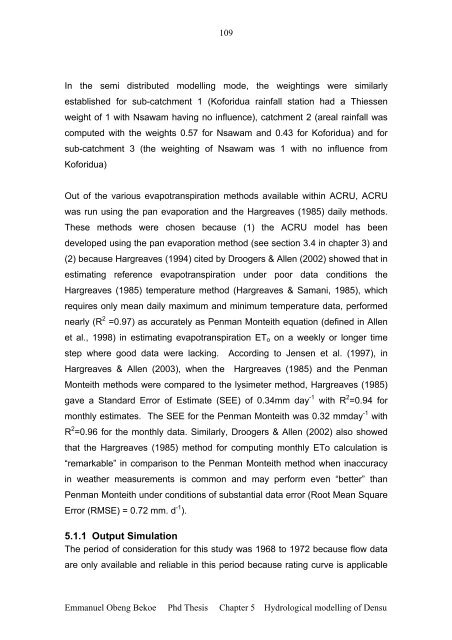PhD Thesis Emmanuel Obeng Bekoe - Cranfield University
PhD Thesis Emmanuel Obeng Bekoe - Cranfield University
PhD Thesis Emmanuel Obeng Bekoe - Cranfield University
Create successful ePaper yourself
Turn your PDF publications into a flip-book with our unique Google optimized e-Paper software.
109<br />
In the semi distributed modelling mode, the weightings were similarly<br />
established for sub-catchment 1 (Koforidua rainfall station had a Thiessen<br />
weight of 1 with Nsawam having no influence), catchment 2 (areal rainfall was<br />
computed with the weights 0.57 for Nsawam and 0.43 for Koforidua) and for<br />
sub-catchment 3 (the weighting of Nsawam was 1 with no influence from<br />
Koforidua)<br />
Out of the various evapotranspiration methods available within ACRU, ACRU<br />
was run using the pan evaporation and the Hargreaves (1985) daily methods.<br />
These methods were chosen because (1) the ACRU model has been<br />
developed using the pan evaporation method (see section 3.4 in chapter 3) and<br />
(2) because Hargreaves (1994) cited by Droogers & Allen (2002) showed that in<br />
estimating reference evapotranspiration under poor data conditions the<br />
Hargreaves (1985) temperature method (Hargreaves & Samani, 1985), which<br />
requires only mean daily maximum and minimum temperature data, performed<br />
nearly (R 2 =0.97) as accurately as Penman Monteith equation (defined in Allen<br />
et al., 1998) in estimating evapotranspiration ETo on a weekly or longer time<br />
step where good data were lacking. According to Jensen et al. (1997), in<br />
Hargreaves & Allen (2003), when the Hargreaves (1985) and the Penman<br />
Monteith methods were compared to the lysimeter method, Hargreaves (1985)<br />
gave a Standard Error of Estimate (SEE) of 0.34mm day -1 with R 2 =0.94 for<br />
monthly estimates. The SEE for the Penman Monteith was 0.32 mmday -1 with<br />
R 2 =0.96 for the monthly data. Similarly, Droogers & Allen (2002) also showed<br />
that the Hargreaves (1985) method for computing monthly ETo calculation is<br />
“remarkable” in comparison to the Penman Monteith method when inaccuracy<br />
in weather measurements is common and may perform even “better” than<br />
Penman Monteith under conditions of substantial data error (Root Mean Square<br />
Error (RMSE) = 0.72 mm. d -1 ).<br />
5.1.1 Output Simulation<br />
The period of consideration for this study was 1968 to 1972 because flow data<br />
are only available and reliable in this period because rating curve is applicable<br />
<strong>Emmanuel</strong> <strong>Obeng</strong> <strong>Bekoe</strong> Phd <strong>Thesis</strong> Chapter 5 Hydrological modelling of Densu

















